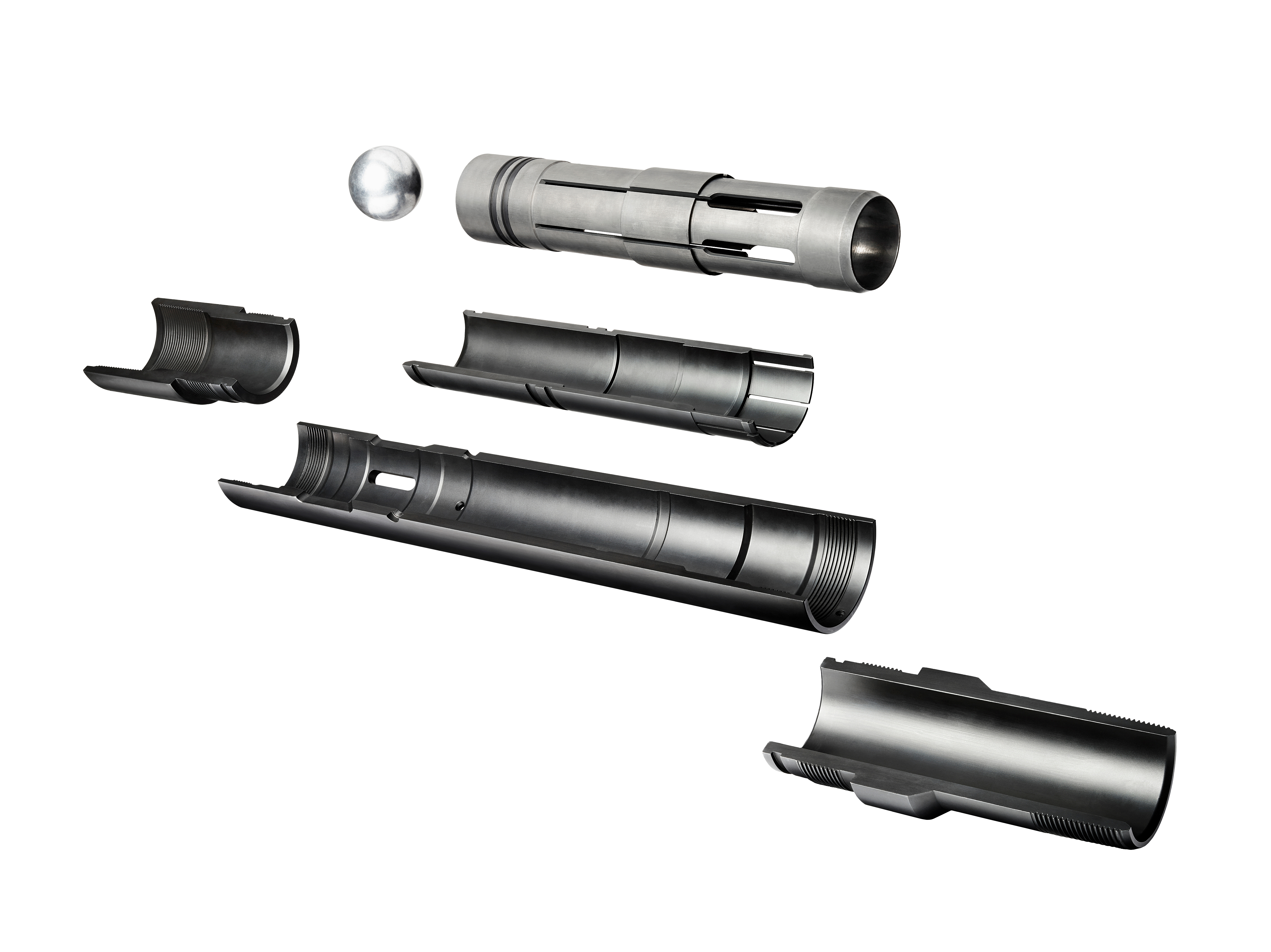The onset of the shale boom has been a result of the application of technical innovations and the realization of cost reductions to increase EUR. Among these innovations has been the incorporation of sliding sleeves into multistage horizontal completions.
Sliding sleeves have also recently been run as integral components of cemented casing strings. A wiper dart is run through the sliding sleeve inside diameter (ID) during the cementing process and the ball seat is wiped clean. In this process the sleeves are opened and the stimulation pressure applied through the ports breaks through the casing cement sheath to allow fracture treatment directly at the sliding sleeve. As in openhole applications, the cemented sliding sleeves allow single-point entry stimulation to be initiated at the open ports.
For coiled tubing (CT)-activated sliding sleeve applications, each individually opened sleeve allows a singlepoint entry stimulation treatment to be initiated at the open ports, and downtime between treatments is reduced since e-line plugs and perforating are eliminated. However, for CT applications the flow path for stimulation pumping is the annular area between the outside of the CT and liner ID. This is a reduced area compared to the fullbore liner flow area and can potentially limit the pump rate, which can be applied during treatment. Also, friction between the CT and liner wall can limit the length of reach within a lateral to access sliding sleeves.
As with the CT-activated system, the ball-drop system allows a single-point entry fracture treatment to be initiated through the open ports of the sleeve, and downtime between pumping operations is reduced due to the elimination of e-line operations associated with setting plugs and perforating. There can be limitations unique to this system, however. Originally, the ball and seats were graduated in ¼-in. increments, and the reduction in seat IDs quickly reduced the number of sliding sleeves that could be run in a lateral. The designs progressively improved to incorporate more ball seat IDs along with methods to activate multiple sliding sleeves having the same ID in a given stage. The ability to mill out seat IDs also is incorporated in some designs. The ball-drop system has the capability to incorporate up to 50 stages, but the ever-growing demand for longer laterals may present renewed challenges.
Addressing design challenges
Stage Completions’ new collet-activated sliding sleeve fracturing system, the SC Bowhead II, addresses potential design limitations of traditional single-point entry systems and can be utilized in openhole or cased-hole applications. The sliding sleeves have only one moving part and are installed integrally with the casing string or liner and offer multiple profile length internal configurations. A collet assembly with a matching profile is pumped down hole with a dissolvable ball seated on top of the collet. The collet will pass through the bore of all sliding sleeves it encounters without engaging until it reaches the sleeve, which has the same matching internal profile.

At this point the collet will engage the matching profile in the sleeve and casing pressure can be applied to shift the sleeve downward and latch into position while exposing the open ports of the sleeve. The open ports are located above the ball and collet and provide a point of initiation for the stimulation treatment. The dissolvable ball will flow off seat with minimal differential pressure due to a unique carrier design while the collet remains locked into the valve housing.
The collet allows the liner to be full-drift diameter to the surface while fracturing each stage, thus reducing friction pressures and pumping time. An equal largebore diameter through each collet after the fracture process allows maximum flowback recovery without intervention. Large-bore access allows cleanouts from heel to toe with no restrictions in coil or tubing size. However, this large bore of the collet is slightly less than liner fullbore. If full liner drift is desired, the collets can be retrieved at any time with CT, and sleeves also can be reclosed for water shutoff or for future refracturing processes.
The future of single-point technology
Data compiled in the field indicate that single-point entry completion technology offers technical advantages for drilling operators mindful of innovation. Single-point entry technology is geared toward efficiently planning and optimizing wells with control and predictability.
The implementation of the SC Bowhead II, a single system that meets the designchange demand limitations of traditional single-point entry fracturing systems, has resulted in potential cost reductions for hydraulic fracturing operations in a variety of ways for operators watching their bottom line in the field. Operators also have reported they have experienced better real-time control during pumping operations, and more accurate treatment modeling has translated into improved production results that have provided across-theboard cost savings.

An operator in the Eagle Ford Shale documented that it completed an extended-reach well with 116 SC Bowhead II collet-activated cementable sliding sleeves. During this deployment and installation of the 15,000-psi system, the operator was able to gain efficiencies by prebucking the SC Bowhead II valves to the casing joints allowing a safer handling of equipment on the rig floor, reduced installation time and much tighter fracture stage spacing.
In additional hydraulic fracturing operations, 117 intervals were stimulated with the Bowhead system in what was documented as a record time of 160 hours while accurately placing 11.6 MMlb of sand and 361,000 bbl of fluid at a maximum sand concentration of 4.7 ppg and a 42-bbl/min average rate. The success of the operation was deemed to be a result of running a dissolvable ball on a collet that activates the sliding sleeves and eliminates the need of employing CT or wireline into the fracturing process.
When it comes to higher pump rates, the Bowhead series has a constant ID throughout the wellbore that facilitates sustaining these higher pump rates and higher sand concentrations. Furthermore, eliminating CT and ball seats creates reduced friction during the fracturing treatment and has decreased the required horsepower of fracturing operations by as much as 60%. The result has allowed operators to maximize efficiency by successfully optimizing every stage and augment the ability of operators to stimulate reservoir volume.
Recommended Reading
Green Swan Seeks US Financing for Global Decarbonization Projects
2024-02-21 - Green Swan, an investment platform seeking to provide capital to countries signed on to the Paris Agreement, is courting U.S. investors to fund decarbonization projects in countries including Iran and Venezuela, its executives told Hart Energy.
TPG Adds Lebovitz as Head of Infrastructure for Climate Investing Platform
2024-02-07 - TPG Rise Climate was launched in 2021 to make investments across asset classes in climate solutions globally.
Sherrill to Lead HEP’s Low Carbon Solutions Division
2024-02-06 - Richard Sherill will serve as president of Howard Energy Partners’ low carbon solutions division, while also serving on Talos Energy’s board.
Greenbacker Names New CFO, Adds Heads of Infrastructure, Capital Markets
2024-02-02 - Christopher Smith will serve as Greenbacker’s new CFO, and the power and renewable energy asset manager also added positions to head its infrastructure and capital markets efforts.
Humble Midstream II, Quantum Capital Form Partnership for Infrastructure Projects
2024-01-30 - Humble Midstream II Partners and Quantum Capital Group’s partnership will promote a focus on energy transition infrastructure.





